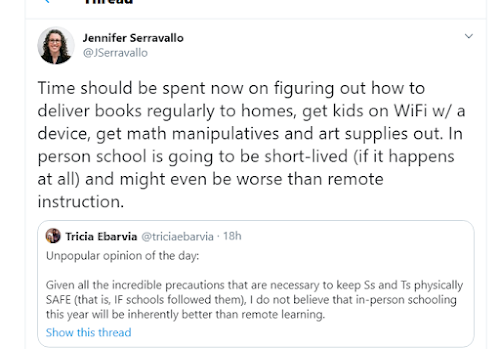While Amazon may call it "Immersion Reading", I prefer the term Carol Chomsky coined in her classic 1976 article, After Decoding, What?, "assisted reading." Chomsky wrote about her work with a group of third grade students who had had plenty of phonics instruction, but had not developed any fluency in their reading. She had the children read story books repeatedly while they listened to the story being read aloud on tape. She wanted the children to read the books over and over again until they could read them back to her fluently without assistance. Chomsky was searching for a method that would "capture their attention and make large amounts of textual material available" (p. 288). She determined that what these students needed was to "shift their focus from the individual word to connected discourse and to integrate their fragmented knowledge" (p. 289).
The students, of course, were not strictly "reading" in the traditional sense, but combining memorization with reading to capture a more fluent account of the text. This new found fluency allowed the readers to engage with the text in ways they were unable to before, so that they gained the pleasure of actually being able to understand the text and talk about it and write about it. Indeed, Chomsky found that these vulnerable readers took great joy in their accomplishments and that writing about what they had read increased their engagement and comprehension. She also found that the gains made in assisted reading resulted in a greater willingness to read in other environments and to choose reading as a "free time" activity.
Subsequent research has supported Chomsky's findings. Repeated reading has been shown to be an effective strategy for improving decoding, comprehension, and fluency. I have written about the strategy in The Power of Rereading and Reading Fluency: Building Bridges from Decoding to Comprehension. The leading expert on fluency instruction in the country, Tim Rasinski is also an advocate of Chomsky's methodology as he discussed in a blog entry on The Robb Review, The Goal of Phonics Instruction is to Get Readers to Not Use Phonics When Reading. And as Rasinski notes, recent research by Stevens, Walker and Vaughn (2017) who were studying students with learning disabilities found that "assisted reading with audiobooks produced gains in reading fluency and comprehension" (p. 576).
Chomsky added some activities as follow up to the students repeated reading/listening to the stories. As I mentioned, having the students write about their reading seemed to play an important role in their progress. They wrote responses to the stories, answered questions in writing ,and made up sentences using words from the stories.
Chomsky also did some word work with the children after they had mastered the stories. When I was working as a clinician at the Rider University Reading/Writing Clinic, I also used this strategy to good effect. Chomsky took some index cards and cut a "word sized" window into them. She would then move the index card around on the text exposing just one word to see if the student could identify the word. If the student could, she moved on to another word. If the student couldn't, Chomsky picked up the card and the student could then read the full sentence and identify the word that way. The goal here was to supplement the rote recognition that came from memorization with the study of the orthographic features of the words. The idea was to keep the instruction light and game-like, but at the same time help the students look closely at the words and develop their understanding of how words work.
Assisted reading, let's call it the read along, has proven to be an effective strategy for helping vulnerable readers. Today's technology makes the potential success for assisted reading as an instructional technique even greater. The need for strategies that vulnerable readers can do in the home during this time of pandemic and that is likely to engage them in more real reading makes assisted reading a particularly attractive strategy for the moment.
Works Cited
Chomsky, C. (1976) After Decoding, What? Language Arts, 53, 3, 288-296.
Rasinski, T. (2018) The Goal of Phonics Instruction is to Get Readers to Not Use Phonics When Reading. The Robb Review.
Stevens, E., Walker, M., & Vaughn, S. (2017). The effects of fluency interventions on the reading fluency and reading comprehension performance of elementary students with learning disabilities: A Synthesis of the research from 2001-2014. Journal of Learning Disabilities, 50, 576-590.




